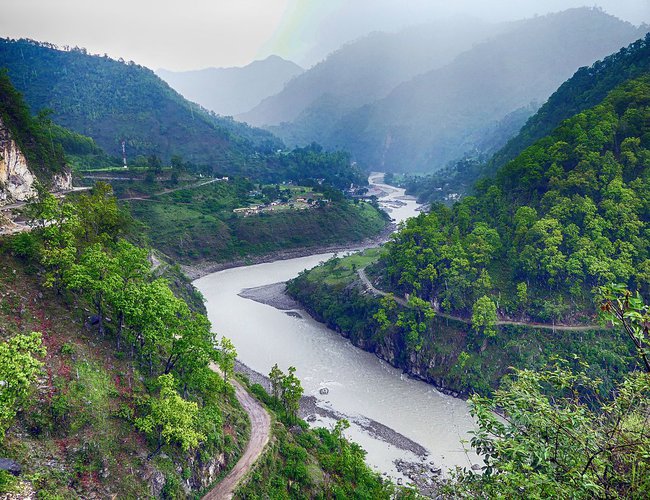
It appears that the authorities of India as well as Nepal are confused over issues about actual existing consumptive use of Mahakali River waters in India vis-à-vis such use in post-Pancheshwor period. It can be explained based on more accurate interpretation of relevant clauses of the Mahakali Treaty paying due attention to hydrology, precedent set by 1959 Gandak Treaty and published irrigation data of Indian Agricultural Research Institute, New Delhi that in post Pancheshwor period Indian claim for additional waters in compensation for pre-Pancheshwor period irrigation cannot be justified. Nepal must be entitled to full 50% share in total regulated flow of the Mahakali River.
The Treaty
Nepal and India had signed on February 12, 1996 Treaty concerning the Integrated Development of the Mahakali River including Sarada Barrage, Tanakpur Barrage and Pancheshwar Project. As required according to our constitution, the Treaty had been ratified by a majority of 2/3 members of our Parliament amidst strong disapproval of many parliamentarians.
Needless to say that our Government must implement the Pancheshwar Project strictly adhering each proviso of the Treaty based on correct interpretation.
Indian Claim based on Article 3 of the Treaty
Indian side is claiming additional regulated waters in post Pancheshwor period in compensation for pre-Pancheshwor period irrigation interpreting the Article 3 of the Treaty (presented hereinafter) in their own way which flies in the face of even the modest analysis and already established precedent for other similar river treaty signed between Nepal and India .
"Pancheshwar Multipurpose Project is to be constructed on a stretch of Mahakli River….without prejudice to their respective existing consumptive uses…."
Why Indian Claim is not justified?
It is stated in the Article 3 of the Treaty that Pancheshwor Project should be constructed without prejudice to their respective existing consumptive uses of the waters of the Mahakali River without specifying the amount of existing use. Exclusion of the amount of existing use of Mahakli waters in India in the Treaty is a clear indication that Indian side then did not intend to lay claim for additional waters in compensation for existing use or else they would have definitely required inclusion of a special clause to quantify existing use following the rule of precedent already established in the 1959 Gandak Treaty. They must have been fully content with the fact that after all the Indian share of regulated water in post-Pancheshwor period would far exceed the pre-Pancheshwor existing use in India. Thus the Pancheshwor Project would not prejudice to India's existing consumptive use.
Hydrology and Existing Use
At present dry season irrigation for Rabi crop in project area in India is greatly constrained by insufficiency of water due to reduction in river flow. Now around 80% probable dry season flow of the Mahakali River is only about 80 cumecs, which is far less than the Indian share of regulated water in post-Pancheshwor period. Thus the implementation of the Mahakali Project would in no way prejudice existing use of Mahakali waters in India in dry season.
Data on consumptive use of water and effective rainfall for various seasons in the project area have been published in the book "WATER RESOURCES OF INDIA AND THEIR UTILIZATION IN AGRICULTURE” by Indian Agricultural Research Institute, New Delhi in 1973. According to that Institute the consumptive use of waters in the project area for kharif crop during monsoon season is between 20 to 40 cm whereas the effective rainfall is 100 cm. It implies that Mahakali River stored water will not be utilized for kharif crop during monsoon period.
True Meaning of the Article 3 of the Treaty
Any person familiar with large storage dam design, construction and operation can ought right say that downstream irrigation can be completely disrupted if adequate provisions are not made in design and construction of the project. Thus the implementation of Pancheshwor Project would definitely prejudice the existing use if the following provisions are not made.
Reservoir Filling
During the initial reservoir filling the river can virtually dry up. The downstream consumptive uses must be ensured by providing outlets at different heights at relatively high cost.
Reregulating Reservoir
The Pancheshwor Project is being planned as a short duration peaking power station. Each day the power station might be in operation only for 4 to 5 hours. During the rest of the time the power station would remain virtually turned off. In post Pancheshwor period it would be necessary to have reregulation reservoir downstream Pancheshwor dam to ensure proper irrigation in Indian Territory.

Dr. A.B. Thapa
Thapa writes on water resources issue
- Dudhkosi Multipurpose Project
- Jul 11, 2022
- Dudh-Kosi Power Project And Kosi Treaty
- Sep 27, 2021
- Uttarakhand Glaciers And Recent Disaster: A Lesson To Our Country
- Mar 02, 2021
- Multipurpose Langtang After Melamchi: Inter-Basin Water Transfer
- Nov 04, 2020
- Large Storage Dams Projects Wary of Giving Away Children’s Inheritance
- Dec 22, 2019












